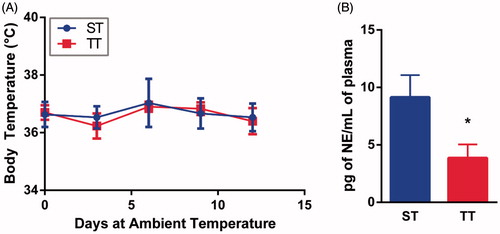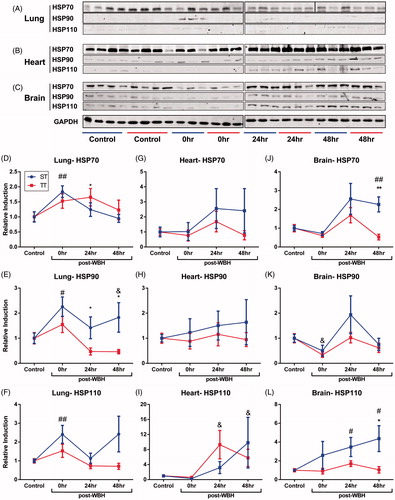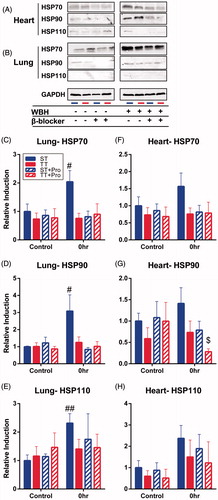Figures & data
Figure 1. Body temperature does not change in mice housed at ST and TT, but plasma norepinephrine levels are increased in mice maintained at ST. (A) Core body temperature of mice housed at ST and TT for 12 days. No significant differences by two-way ANOVA; n = 3. (B) Plasma levels of norepinephrine from mice acclimated to ST and TT for 14 days. *p < 0.05 by Student’s t-test; n = 8.

Figure 2. Housing mice at TT does not significantly alter baseline expression of HSPs. Brain, lung, and heart expression of (A) total Hsp70 (B) Hsp90 (C) Hsp110 of mice housed for 14 days at ST and TT. No statistically significant differences by Student’s t-test. n = 3–4/experiment, experiments were performed twice and data were combined.

Figure 3. The expression of heat shock proteins is decreased in visceral organs of mice housed at TT compared to mice housed at ST after WBH. (A) Lung, (B) heart, and (C) brain expression of Hsp70, Hsp90 and Hsp110 following 6 h of whole body hyperthermia. (D–L) Fluorescence intensity of heat shock protein expression relative to unheated ST or TT controls. *p < 0.05, **p < 0.01 (ST vs. TT), #p < 0.05, ##p < 0.01 (heated ST vs. unheated ST control), &p < 0.05 (heated TT vs. unheated TT control) by Student’s t-test; n = 3–4 per experiment, each experiment was performed twice and combined.

Figure 4. The induction of heat shock proteins is abrogated by propranolol in mice housed at ST after WBH. (A) Lung and (B) heart expression of Hsp70, Hsp90 and Hsp110 following 6 h of WBH with and without the β-blocker propranolol. (C–H) Densitometry quantifications of Hsp expression relative to unheated ST only, TT only, ST + propranolol, and TT + propranolol. #p < 0.05, ##p < 0.01 (heated ST vs. unheated ST control), $p < 0.05 (heated TT + propranolol compared to unheated TT + propranolol) by Student’s t-test; n = 3–4/experiment, each experiment was performed twice and combined.

